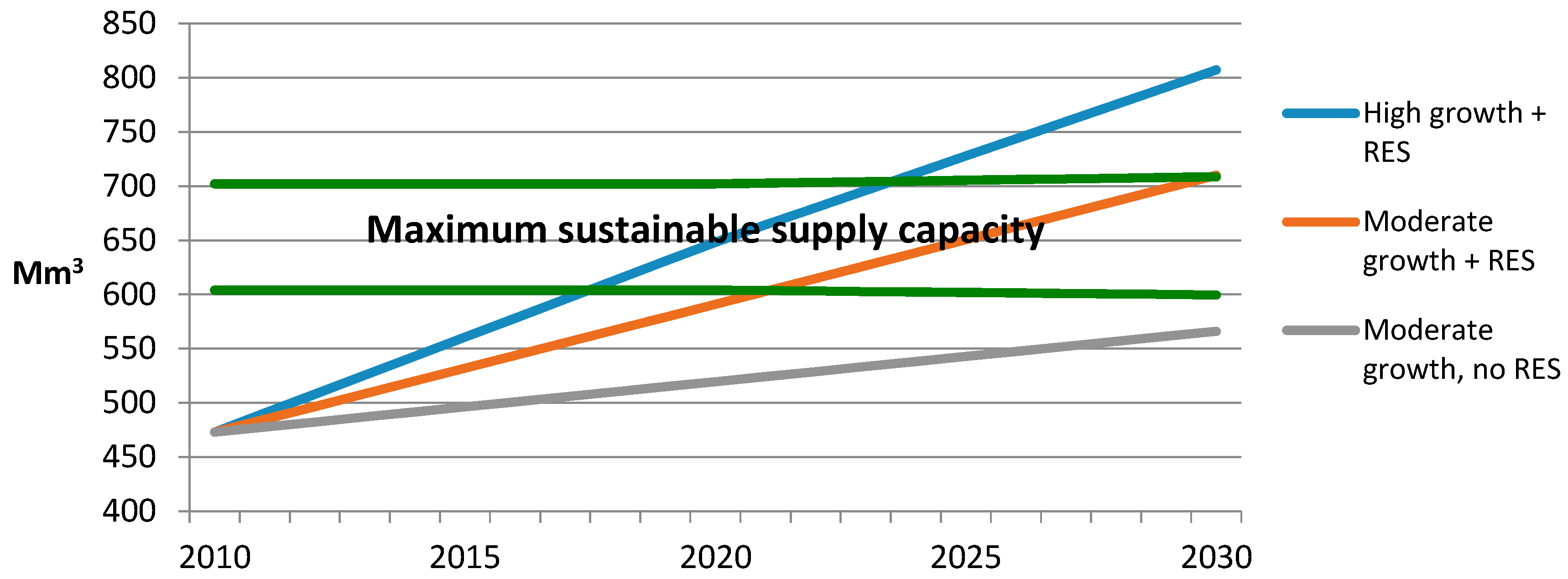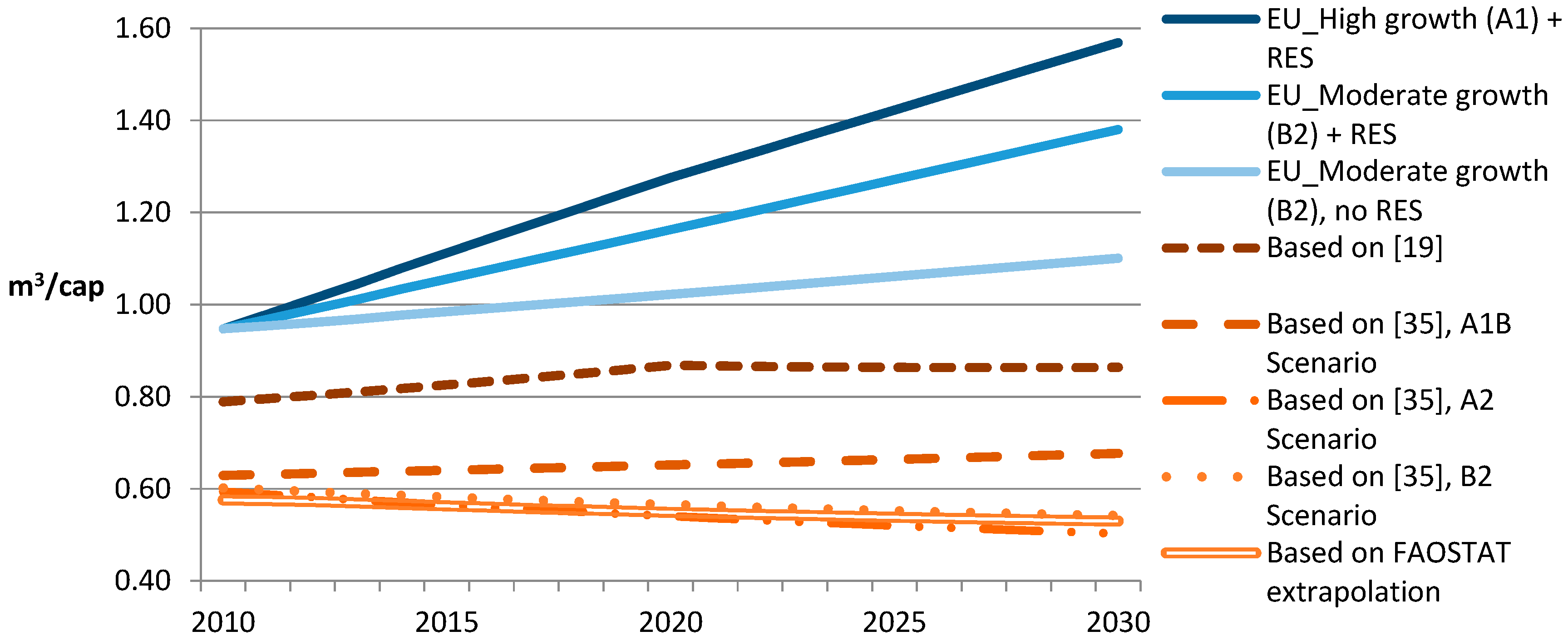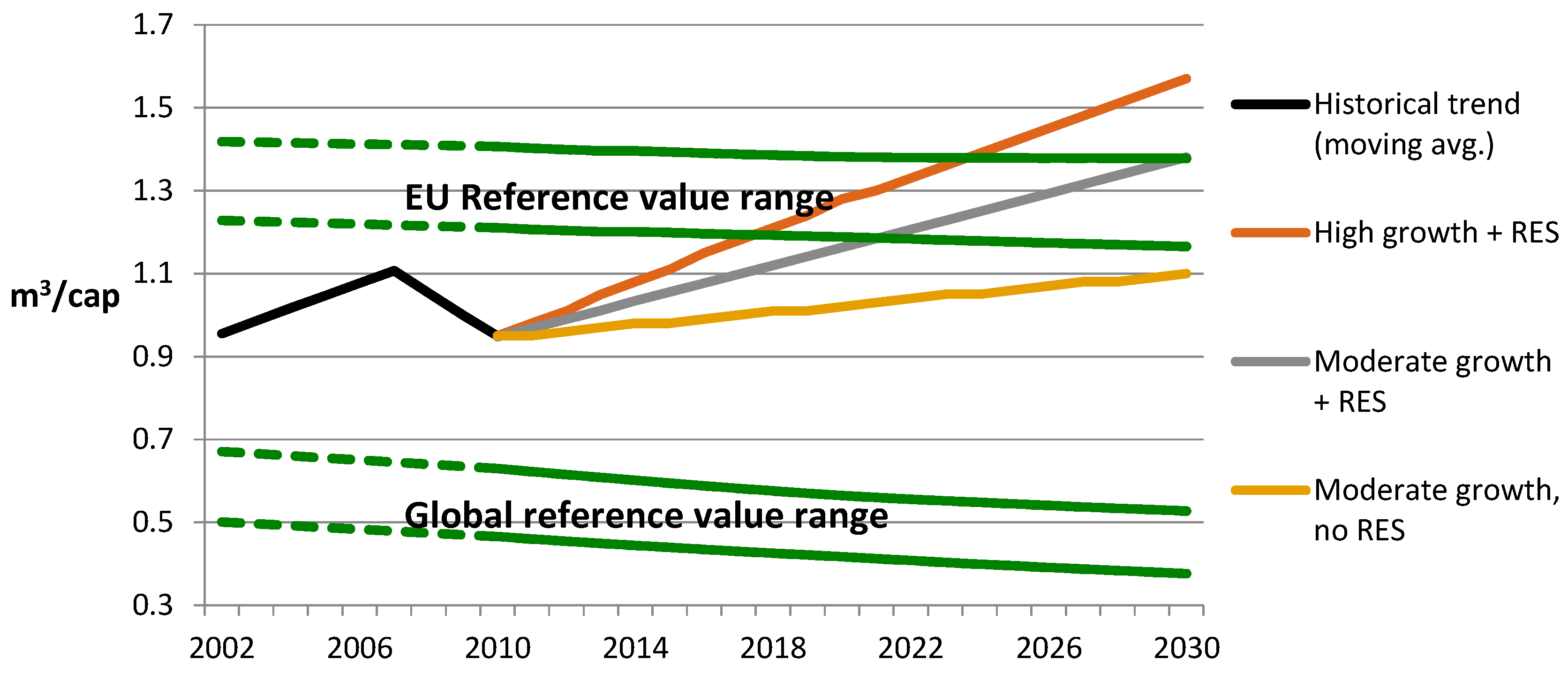Assessing the Sustainability of EU Timber Consumption Trends: Comparing Consumption Scenarios with a Safe Operating Space Scenario for Global and EU Timber Supply
Abstract
:1. Introduction
2. Scenarios of Timber Consumption
2.1. Global Scenarios
2.2. EU Scenarios
3. Materials and Methods
3.1. Global Consumption Patterns
3.2. EU-27 Consumption Patterns
- High growth + RES: Scenario A1 for products and meeting the RES Directive targets for fuel. This scenario is based on the EUWood project [39]. It should be noted that energy wood volumes are based on the literature estimates, which calculated volumes needed for 2030 before revised targets were established in 2014. This implies that lower volumes of wood energy than depicted here may be needed to meet targets, thus indicating a potential overestimation.
- Moderate growth + RES: Scenario B2 for products and meeting the RES Directive targets for fuel. This scenario is based on estimates derived from EFSOS II [18]. It should be noted that these differ somewhat from estimates based on the EUWood project as regards products (estimates between studies for meeting renewable energy targets differ by just 1 M3 in 2030). EFSOS II has a lower product demand in the B2 scenario due to revised estimates for paper consumption (reflecting a decreasing trend for graphic paper due to competition with electronic media; it should be noted that this trend is actually more pronounced than estimated, potentially leading to even lower levels of demand for products and more opportunity for energy wood).
- Moderate growth, no RES: Scenario B2 for products and continuation of past trends for fuelwood (extrapolation of 1.5% per year). This scenario is based on the reference scenario from EFSOS II [18].
4. Results
5. Discussion
6. Conclusions
Acknowledgments
Author Contributions
Conflicts of Interest
References
- EU. Directive 2009/28/EC on the Promotion of the Use of Energy from Renewable Sources an Demanding and Subsequently Repealing Directives 2001/77/EC and 2003/30/EC; EU: Brussels, Belgium, 2009; Volume 140, pp. 16–62. [Google Scholar]
- Eurostat. Statistics Explained: Energy from Renewable Sources, version 17.06.2014; Eurostat: Luxembourg, 2014. [Google Scholar]
- Schulze, E.D.; Körner, C.; Law, B.E.; Haberl, H.; Luyssaert, S. Large-scale bioenergy is neither sustainable nor greenhouse gas neutral. Glob. Chang. Biol. Bioenergy 2012, 4, 611–616. [Google Scholar] [CrossRef]
- Haberl, H.; Schultze, E.-D.; Körner, C.; Law, B.E.; Holtsmark, B.; Luyssaert, S. Response: Complexities of sustainable forest use. Glob. Chang. Biol. Bioenergy 2013, 5, 1–2. [Google Scholar] [CrossRef]
- Agostini, A.; Giuntoli, J.; Boulamanti, A. Carbon Accounting of Forest Bioenergy; Marelli, L., Ed.; European Union Joint Research Centre: Ispra, Italy, 2013. [Google Scholar]
- Gibson, L.; Lee, T.M.; Koh, L.P.; Brook, B.W.; Gardner, T.A.; Barlow, J.; Peres, C.A.; Bradshaw, C.J.A.; Laurance, W.F.; Lovejoy, T.E.; et al. Primary forests are irreplaceable for sustaining tropical biodiversity. Nature 2011, 478, 378–381. [Google Scholar] [CrossRef] [PubMed]
- UNEP. Assessing Global Land Use: Balancing Consumption with Sustainable Supply; A Report of the Working Group on Land and Soils of the International Resource Panel; UNEP: Nairobi, Kenya, 2014. [Google Scholar]
- Smeets, E.; Faaij, A. Bioenergy production potentials from forestry to 2050. Clim. Chang. 2007, 81, 353–390. [Google Scholar] [CrossRef]
- Anttila, P.; Karjalainen, T.; Asikainen, A. Global Potential of Modern Fuelwood; Finnish Forest Research Institute: Helsinki, Finland, 2009. [Google Scholar]
- Karjalainen, T.; Asikainen, A.; Ilavsky, J.; Zamboni, R.; Hotari, K.-E.; Röser, D. Estimation of Energy Wood Potential in Europe; Working Paper of the Finnish Forest Research Institute 6; Finnish Forest Research Institute: Helsinki, Finland, 2004. [Google Scholar]
- Ericsson, K.; Nilsson, L.J. Assessment of the potential biomass supply in Europe using a resource—Focused approach. Biomass Bioenergy 2006, 30, 1–15. [Google Scholar] [CrossRef]
- Alakangas, E.; Heikkinen, A.; Lensu, T.; Vesterinen, P. Biomass Fuel Trade in Europe; Report of the EUBIONET II Project; VTT Technical Research Centre of Finland: Espoo, Finland, 2007. [Google Scholar]
- Asikainen, A.; Liiri, H.; Peltola, S.; Karjalainen, T.; Laitila, J. Forest Energy Potential in Europe (EU 27); Metla Working Papers 69; Finnish Forest Research Institute: Helsinki, Finland, 2008. [Google Scholar]
- Verkerk, P.J.; Anttila, P.; Eggers, J.; Lindner, M.; Asikainen, A. The realisable potential supply of woody biomass from forests in the European Union. For. Ecol. Manag. 2011, 261, 2007–2015. [Google Scholar] [CrossRef]
- Hennenberg, K.; Böttcher, H.; Wiegmann, K.; Forsell, N.; Korosuo, A.; Havlík, P.; Valin, H.; Lauri, P.; Gusti, M.; Kindermann, G.; et al. Study on Impacts on Resource Efficiency of Future EU Demand for Bioenergy—Task 2: Analysis of Impacts of Biomass Production on Natural Resources and the Global Environment; European Commission: Brussels, Belgium, 2014. [Google Scholar]
- Moffat, A.; Nisbet, T.; Nicoll, B. Environmental Effects of Stump and Root Harvesting; Research Note; 2011. Available online: http://www.forestry.gov.uk/pdf/FCRN009.pdf/$FILE/FCRN009.pdf (accessed on 22 November 2017).
- Vanhala, P.; Repo, A.; Liski, J. Forest bioenergy at the cost of carbon sequestration? Curr. Opin. Environ. Sustain. 2013, 5, 41–46. [Google Scholar] [CrossRef]
- UNECE; FAO; UN. The European Forest Sector Outlook Study II: 2010–2030; United Nations: Geneva, Switzerland, 2012. [Google Scholar]
- FAO. State of the World’s Forests 2009; Food and Agricultural Organization of the United Nations: Rome, Italy, 2009. [Google Scholar]
- Burger, J.A. Management effects on growth, production and sustainability of managed forest ecosystems: Past trends and future directions. For. Ecol. Manag. 2009, 258, 2335–2346. [Google Scholar] [CrossRef]
- Nasi, R.; Frost, P.G.H. Sustainable forest management in the tropics: Is everything in order but the patient still dying? Ecol. Soc. 2009, 14, 40. [Google Scholar] [CrossRef]
- Warman, R.D. Global wood production from natural forests has peaked. Biodivers. Conserv. 2014, 23, 1063–1078. [Google Scholar] [CrossRef]
- Payn, T.; Carnus, J.M.; Freer-Smith, P.; Kimberley, M.; Kollert, W.; Liu, S.; Orazio, C.; Rodriguez, L.; Silva, L.N.; Wingfield, M.J. Changes in planted forests and future global implications. For. Ecol. Manag. 2015, 352, 57–67. [Google Scholar] [CrossRef]
- Cubbage, F.; Mac Donagh, P.; Sawinski, J.; Rubilar, R.; Donoso, P.; Ferreira, A.; Hoeflich, V.; Olmos, V.V.; Ferreira, G.; Balmeilli, G.; et al. Timber investment returns for selected plantations and native forests in South America and the Southern United States. New For. 2007, 33, 237–255. [Google Scholar] [CrossRef]
- Hurmekoski, E.; Hetemäki, L. Studying the Future of the Forest Sector: Review and Implications for Long-Term Outlook Studies. For. Policy Econ. 2013, 34, 17–29. [Google Scholar] [CrossRef]
- Opschoor, J.B.; Weterings, R. Environmental Utilisation Space: An Introduction. Tijdschrift Voor Milieukunde 1994, 9, 198–205. [Google Scholar]
- Bund für Umwelt- und Naturschutz Deutschland (BUND); Misereor (Eds.) Zukunftsfähiges Deutschland: Ein Beitrag zu Einer Global Nachhaltigen Entwicklung [Sustainable Germany in a Globalized World: Toward Global Sustainable Development]; Birkäuser Verlag: Basel, Switzerland; Bonn, Germany; Berlin, Germany, 1996. [Google Scholar]
- UN (United Nations). Agenda 21. In Proceedings of the United Nations Conference on Environment & Development, Rio De Janerio, Brazil, 3–4 June 1992. [Google Scholar]
- O’Brien, M. Timber Consumption and Sustainable Forest Use: Assessing the EU’s Current and Expected Consumption of Global Timber in Relation to the Global Capacity for Sustainable Supply; Kassel University Press: Kassel, Germany, 2016. [Google Scholar]
- O’Brien, M.; Bringezu, S. European timber consumption: Developing a method to account for timber flows and the EU’s global forest footprint. Ecol. Econ. Forthcoming, accepted with minor revisions.
- O’Brien, M.; Bringezu, S. What Is a Sustainable Level of Timber Consumption in the EU: Toward Global and EU Benchmarks for Sustainable Forest Use. Sustainability 2017, 9, 812. [Google Scholar] [CrossRef]
- EREP. Manifesto and Policy Recommendations of the European Resource Efficiency Platform; European Commission: Brussels, Belgium, 2014. [Google Scholar]
- Tukker, A.; Bulavskaya, T.; Giljum, S.; de Koning, A.; Lutter, S.; Simas, M.S.; Stadler, K.; Wood, R. The Global Resource Footprint of Nations—Carbon, Water, Land, and Materials Embodied in Trade and Final Consumption Calculated with EXIOBASE 2.1; The Netherlands Organisation for Applied Scientific Research: Delft, The Netherlands; Leiden University: Leiden, The Netherlands; Vienna University of Economics and Business: Vienna, Austria; Norwegian University of Science and Technology: Trondheim, Norway, 2014. [Google Scholar]
- Giljum, S.; Lutter, S.; Bruckner, M.; Aparcana, S. State-of-Play of National Consumption Based Indicators: A Review and Evaluation of Available Methods and Data to Calculate Footprint-Type (Consumption-Based) Indicators for Materials, Water, Land and Carbon; Sustainable Europe Research Institute: Vienna, Austria, 2013. [Google Scholar]
- Buongiorno, J.; Zhu, S.; Raunikar, R.; Prestemon, J. Outlook to 2060 for World Forest and Forest Industries; A Technical Document Supporting the Forest Service 2010 RPA Assessment; USDA: Ashville, AL, USA, 2012.
- Raunikar, R.; Buongiorno, J.; Turner, J.A.; Zhu, S. Global outlook for wood and forests with the bioenergy demand implied by scenarios of the Intergovernmental Panel on Climate Change. For. Policy Econ. 2010, 12, 48–56. [Google Scholar] [CrossRef]
- Jonsson, R. Econometric Modeling and Projections of Wood Products Demand, Supply and Trade in Europe; Geneva Timber and Forest Discussion Paper 59; United Nations Publication: Geneva, Switzerland, 2012. [Google Scholar]
- Steierer, F. Energy Use; EUwood: Hamburg, Germany, 2010. [Google Scholar]
- Mantau, U.; Saal, U.; Prins, K.; Steierer, F.; Lindner, M.; Verkerk, H.; Eggers, J.; Leek, N.; Oldenburger, J.; Asikainen, A.; et al. Real Potential for Changes in Growth and Use of EU Forests; EUwood: Hamburg, Germany, 2010. [Google Scholar]
- Bringezu, S.; O’Brien, M.; Schütz, H. Beyond biofuels: Assessing global land use for domestic consumption of biomass: A conceptual and empirical contribution to sustainable management of global resources. Land Use Policy 2012, 1, 224–232. [Google Scholar] [CrossRef]
- Council of the European Union. Addressing the Challenges of Deforestation and Forest Degradation to Tackle Climate Change and Biodiversity Loss; Council of the European Union: Brussels, Belgium, 2008. [Google Scholar]
- Steffen, W.; Richardson, K.; Rockström, J.; Cornell, S.E.; Fetzer, I.; Bennett, E.M.; Biggs, R.; Carpenter, S.R.; de Vries, W.; de Wit, C.A.; et al. Planetary boundaries: Guiding human development on a changing planet. Science 2015, 374. [Google Scholar] [CrossRef] [PubMed]
- ILA. New Delhi declaration of principles of international law relating to sustainable development. In Proceedings of the 70th Conference of the International Law Association, New Delhi, India, 2–6 April 2002. [Google Scholar]
- FAO. Global Forest Resources Assessment 2010; FAO Forestry Paper 163; FAO: Rome, Italy, 2010. [Google Scholar]
- UN. World Population Prospects: The 2012 Revision. 2012. Available online: www.unpopulation.org (accessed on 15 March 2014).
- Rockström, J.; Steffen, W.; Noone, K.; Persson, Å.; Chapin, F.S., III; Lambin, E.F.; Lenton, T.M.; Scheffer, M.; Folke, C.; Schellnhuber, H.J.; et al. A safe operating space for humanity. Nature 2009, 461, 472–475. [Google Scholar]
- Nolte, K.; Chamberlain, W.; Giger, M. International Land Deals for Agriculture—Fresh Insights from the Land Matrix: Analytical Report II; Centre for Development and Environment, University of Bern: Bern, Germany; Centre de Coopération Internationale en Recherche Agronomique Pour le Développement: Montpellier, France; German Institute of Global and Area Studies: Hamburg, Germany; University of Pretoria: Pretoria, South Africa; Bern Open Publishing: Bern, Germany, 2016. [Google Scholar]
- Jürgensen, C.; Kollert, W.; Lebedys, A. Assessment of Industrial Roundwood Production from Planted Forests; FAO Planted Forests and Trees Working Paper FP/48/E; FAO: Rome, Italy, 2014. [Google Scholar]
- Ceballos, G.; Ehrlich, P.R.; Dirzo, R. Biological annihilation via the ongoing sixth mass extinction signaled by vertebrate population losses and declines. Proc. Natl. Acad. Sci. USA 2017, 114, E6089–E6096. [Google Scholar] [CrossRef] [PubMed]
- Dornburg, V.; Faaij, A. Costs and CO2-emission reduction of biomass cascading: Methodological aspects and case study of SRF poplar. Clim. Chang. 2005, 71, 373–408. [Google Scholar] [CrossRef]
- Keegan, D.; Kretschmer, B.; Elbersen, B.; Panoutsou, C. Cascading use: A systematic approach to biomass beyond the energy sector. Biofuels Bioprod. Biorefin. 2013, 7, 193–206. [Google Scholar] [CrossRef]
- Essel, R.; Carus, M. Increasing resource efficiency by cascading use of biomass. RURAL21 2014, 48, 28–29. [Google Scholar]
- Vis, M.; Mantau, U.; Allen, B. (Eds.) Study on the Optimised Cascading Use of Wood; Final Report, No 394/PP/ENT/RCH/14/7689; EU: Brussels, Belgium, 2016. [Google Scholar]
- UN. A New Global Partnership: Eradicate Poverty And Transform Economies Through Sustainable Development; The Report of the High-Level Panel of Eminent Persons on the Post-2015 Development Agenda; UN: New York, NY, USA, 2013. [Google Scholar]
- UNEP. Policy Coherence of the Sustainable Development Goals: A Natural Resource Perspective; A Report of the International Resource Panel; UNEP: Nairobi, Kenya, 2015. [Google Scholar]
- Howlett, M.; Rayner, J. Design Principles for Policy Mixes: Cohesion and Coherence in “New Governance Arrangements”. Policy Soc. 2007, 26, 1–18. [Google Scholar] [CrossRef]
| 1 | E.g., The New Generation Plantations platform aims to promote establishment of forest plantations that contribute positively to local welfare and natural ecosystems: http://newgenerationplantations.org. |
| 2 | Footprints describe a consumption-oriented approach for monitoring environmental pressures. The four footprints—materials, water, carbon and land—are gaining increasing attention at both the European and international levels [7,32,33], although the methodological robustness and level of calculation differs widely among all categories [34]. The initial and rough footprint methodology for forestry applied by [30] is based on accounting for removals plus imports minus exports. Trade data are converted to primary timber equivalents through conversion values and all secondary flows reported by the data were removed. They are reported in cubic meters per capita and refer to primary raw timber demand (e.g., woody biomass from forest areas, excluding recycled and reused sources). |
| 3 | See the website of the United Nations: https://sustainabledevelopment.un.org/?menu=1300. |
| 4 | Note, this is “safe operating space scenario” is more ambitious than but in keeping with the aim of the European Union to support efforts to “halt global forest cover loss by 2030 at the latest and to reduce gross tropical deforestation by at least 50% by 2020 compared to current levels” [41] (p. 5). It is also more ambitious than the planetary boundary for forest cover change suggested by [42], which is related primarily to the climate impacts of forest cover change and not the biodiversity impacts. |
| 5 | This is a set of seven principles adopted by the International Law Association related to sustainable development. The principles were developed due to a concern over “the growing economic and social inequalities between and within States” [43] and the “need for a comprehensive international law perspective on integration of social, economic, financial and environmental objectives and activities” [43]. The second principle addresses equity and the eradication of poverty, including inter- and intra-generational equity. |
| 6 | |
| 7 |




© 2017 by the authors. Licensee MDPI, Basel, Switzerland. This article is an open access article distributed under the terms and conditions of the Creative Commons Attribution (CC BY) license (http://creativecommons.org/licenses/by/4.0/).
Share and Cite
O’Brien, M.; Bringezu, S. Assessing the Sustainability of EU Timber Consumption Trends: Comparing Consumption Scenarios with a Safe Operating Space Scenario for Global and EU Timber Supply. Land 2017, 6, 84. https://doi.org/10.3390/land6040084
O’Brien M, Bringezu S. Assessing the Sustainability of EU Timber Consumption Trends: Comparing Consumption Scenarios with a Safe Operating Space Scenario for Global and EU Timber Supply. Land. 2017; 6(4):84. https://doi.org/10.3390/land6040084
Chicago/Turabian StyleO’Brien, Meghan, and Stefan Bringezu. 2017. "Assessing the Sustainability of EU Timber Consumption Trends: Comparing Consumption Scenarios with a Safe Operating Space Scenario for Global and EU Timber Supply" Land 6, no. 4: 84. https://doi.org/10.3390/land6040084
APA StyleO’Brien, M., & Bringezu, S. (2017). Assessing the Sustainability of EU Timber Consumption Trends: Comparing Consumption Scenarios with a Safe Operating Space Scenario for Global and EU Timber Supply. Land, 6(4), 84. https://doi.org/10.3390/land6040084




